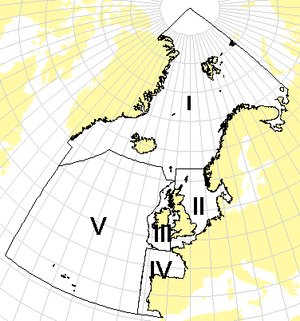OSPAR Convention (Convention for the Protection of the Marine Environment of the North-East Atlantic) and OSPAR Commission
Contents
The North-East Atlantic
This is defined as extending westwards to the east coast of Greenland, eastwards to the continental North Sea coast, south to the Strait of Gibraltar and northwards to the North Pole (see Figure 2). This maritime area does not include the Baltic or Mediterranean seas. The Helsinki Convention (HELCOM, for the Baltic) and Barcelona Convention (for the Mediterranean) apply in these sea areas.
Due to this spatial extent of the Sea itself and its catchment the contracting parties are:
- Belgium
- Denmark
- the European Community
- Finland
- France
- Germany
- Iceland
- Ireland
- Luxembourg
- the Netherlands
- Norway
- Portugal
- Spain
- Sweden
- Switzerland
- the United Kingdom of Great Britain and Northern Ireland
The Convention
The Convention for the Protection of the Marine Environment of the North-East Atlantic (the “OSPAR Convention”) was developed from the 1972 Oslo Convention on dumping waste at sea and the 1974 Paris Convention on land-based sources of marine pollution. It has been signed on 22 September 1992 by all of the Contracting Parties to the original Oslo or Paris Conventions and by Luxembourg and Switzerland. After ratification it entered into force on 25 March 1998 at the Ministerial Meeting of the parent Conventions. The Ministerial Declarations and Statements made at the adoption of the Convention and at the Ministerial Meetings of the OSPAR Commission guide the work under the Convention. Still, Decisions, Recommendations and other agreements made at the parent Conventions remain valid until they are terminated by newly adopted measures under the new Convention.
The full text of the Convention, including all Annexes and Appendices you can read here [1].
While at the first Ministerial Meeting of the OSPAR Commission at Sintra, Portugal, in 1998, the cooperation of the Contracting Parties was extended to cover all human activities that might adversely affect the marine environment of the North East Atlantic (Annex V of the Convention), programs and measures on questions relating to fisheries management cannot be adopted under the Convention.
The Commission
The OSPAR Commission is the forum through which the Contracting Parties cooperate and is made up of representatives of the Governments of 15 Contracting Parties and the European Commission, representing the European Community. Each of the Contracting Parties has 1 vote in the Commision. Important decisions are made unanimously or with three-quarters majority, depending on the issue.
There is usually one meeting per year that is hosted by one of the Contracting Parties. Additional meetings concerning urgent issues can be forced by at least 3 of the Contracting Parties together. In between, the Heads of the Delegations of the Contracting Parties meet regularly to prepare the meetings, to advice in management decisions and to monitor the development and implementations of the agreements made by the Commission.
The Commission is supported by six main committees (one for each strategy – see paragraph "Main targets") some of which are supported by so called working groups. Further support is given by Linguists, Jurists and the Committee of Chairmen and Vice-Chairmen. The Secretariat is headed by an Executive Secretary and is responsible for administrative tasks mainly.
Observers
The work of all above-named groups is watched by different observer organizations. These include intergovernmental organizations from similar fields and non-governmental organizations. The full list of these organizations can be found here [2].
Main targets
The work under the Convention is organised under six strategies:
- Protection and Conservation of Marine Biodiversity and Ecosystems
- Eutrophication
- Hazardous Substances
- Offshore Oil and Gas Industry
- Radioactive Substances
- Monitoring and Assessment
For each of the strategies a committee is formed, that supports the Commission. Some of the committees are in turn supported by working groups.
Tools
The work under the OSPAR Convention applies the ecosystem approach to the management of human activities [3]. The same is valid for the Baltic Marine Environment Protection Commission (the Helsinki Commission – HELCOM).
Quality Status Report
It is based on 5 regional reports (regional QSRs) based on the 5 zones shown on the map (Figure 3). The full report can be read and downloaded here [4].
Joint HELCOM/OSPAR Work Programme on Marine Protected Areas
At the first joint ministerial meeting of the Helsinki and OSPAR commissions (JMM) in Bremen on 25-26 June 2003 the above named programme was adopted. The purpose of the work programme is to ensure that by 2010 there is an ecologically coherent network of well managed marine protected areas (MPAs) for the maritime areas of both HELCOM (Baltic Sea) and OSPAR (North East Atlantic).
Official Site
More information concerning the OSPAR about all meetings, the strategies, measures and publications, can be gathered at the bi-lingual (English/French) Official Site [5].
Please note that others may also have edited the contents of this article.
|



